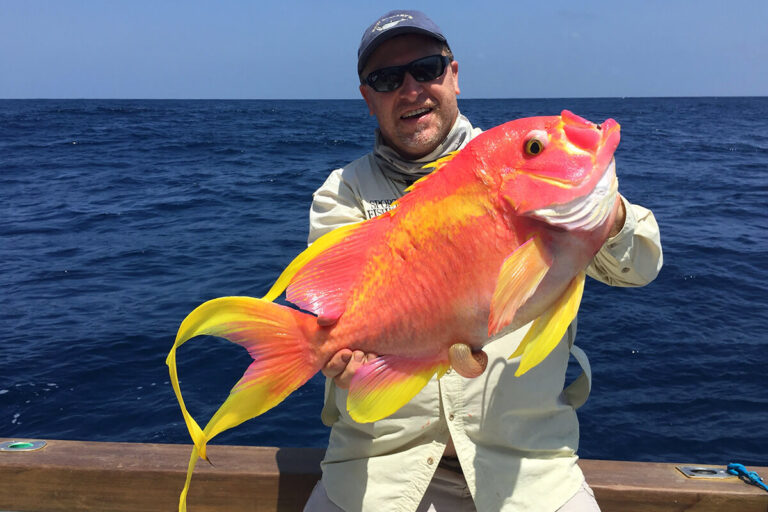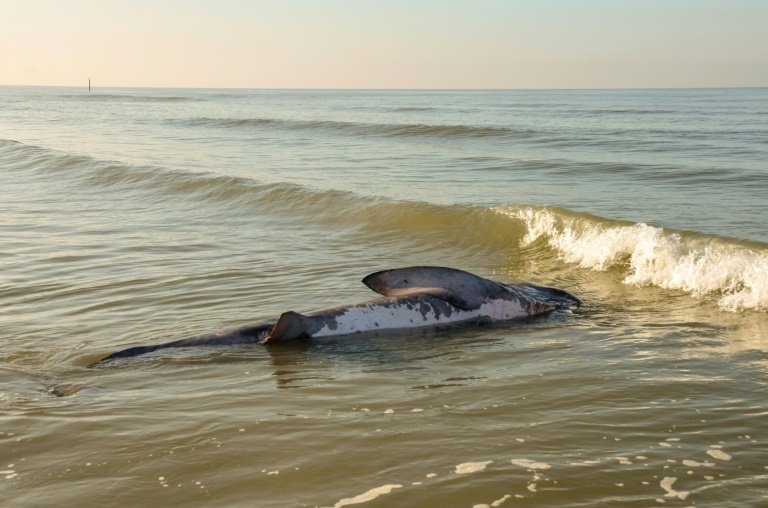Deep sea fishing started in ancient times, with evidence dating back thousands of years. It has since evolved into a popular recreational activity worldwide, offering enthusiasts the chance to catch large and exotic species in the depths of the ocean.
In the vast expanse of the ocean, a thrilling and ancient practice unfolds – deep sea fishing. With origins dating back thousands of years, this exhilarating activity has captivated the hearts of adventurers around the globe. Casting lines into the depths of the sea, anglers aim to hook impressive and exotic species that dwell in these uncharted waters.
From ancient civilizations to modern-day enthusiasts, deep sea fishing has transcended time to become a beloved pastime. We delve into the rich history of deep sea fishing, examining its origins, evolution, and the allure it holds for those who dare to explore the mysterious depths of the ocean.

Credit: scitechdaily.com
Deep Sea Fishing In Ancient Times
————————————————————
Deep sea fishing is an activity that has been practiced by humans for thousands of years. Ancient civilizations were known to venture into the vast oceans in search of a bountiful catch. In this section, we will explore the origins of deep sea fishing in ancient civilizations, the techniques and tools used by early deep sea fishermen, and the role of deep sea fishing in the economy and culture of ancient societies.
Origins Of Deep Sea Fishing In Ancient Civilizations
- Ancient civilizations such as the egyptians, phoenicians, and greeks were among the first to engage in deep sea fishing.
- They realized the abundance of marine life in the deep waters and the potential for sustenance and trade.
- The development of seafaring skills and technologies enabled these civilizations to venture further into the open ocean.
- Deep sea fishing became an integral part of their survival and economic activities.
Techniques And Tools Used By Early Deep Sea Fishermen
- Early deep sea fishermen used various techniques to catch fish in the open ocean, such as:
- Net fishing: Large nets were deployed to catch schools of fish.
- Line fishing: Fishing lines with baited hooks were dropped into the water to lure and catch fish.
- Spearfishing: Skilled fishermen used spears to target individual fish.
- Tools used by early deep sea fishermen included:
- Boats: Sturdy and seaworthy vessels were crafted to withstand the rough seas.
- Fish hooks: Made from bones, shells, or sharpened stones, fish hooks were essential for catching fish.
- Nets: Weaving intricate nets allowed for the capture of larger quantities of fish.
Role Of Deep Sea Fishing In The Economy And Culture Of Ancient Societies
- Deep sea fishing played a vital role in the economy of ancient civilizations.
- It provided a source of sustenance for coastal communities, ensuring their survival and growth.
- The surplus catch from deep sea fishing was traded with inland regions, fostering economic prosperity.
- Deep sea fishing also held cultural significance, with myths, legends, and ceremonies revolving around the sea and its bounty.
- Ancient civilizations revered marine deities, further emphasizing the importance of deep sea fishing in their culture.
- The skills and knowledge passed down through generations formed the backbone of their fishing traditions.
Deep sea fishing in ancient times was not only a means of survival but also a defining aspect of ancient civilizations. The exploration of the open ocean, the techniques and tools employed, and the economic and cultural significance of deep sea fishing helped shape the societies of the past.
Even today, we can appreciate the rich legacy left behind by these early deep sea fishermen.
Advancements In Deep Sea Fishing Techniques
Deep sea fishing has come a long way since its humble beginnings. Over the years, advancements in technology have revolutionized the way we fish in the deep sea. From specialized boats to innovative gear and equipment, these developments have made deep sea fishing more accessible and efficient than ever before.
In this section, we will explore three key areas of advancement in deep sea fishing techniques: the introduction of specialized boats, innovations in fishing gear and equipment, and the impact of advancements in navigation technology.
Introduction Of Specialized Boats For Deep Sea Fishing
Specialized boats have played a crucial role in the evolution of deep sea fishing. These vessels are specifically designed to withstand the harsh conditions of the open ocean and provide an optimal platform for anglers to pursue their catch. Here are some key points regarding the introduction of specialized boats:
- Purpose-built hulls: Specialized boats feature unique hull designs that offer stability and maneuverability in choppy waters.
- Increased deck space: These boats provide ample deck space, allowing anglers to move around comfortably and engage in various fishing techniques.
- Onboard amenities: Modern specialized boats often come equipped with amenities such as restrooms, kitchens, and sleeping quarters, providing anglers with the convenience and comfort needed for extended fishing trips.
Innovations In Fishing Gear And Equipment
Advancements in fishing gear and equipment have revolutionized the way anglers target deep sea fish species. Here are some key points highlighting these innovations:
- High-strength fishing lines: Technological advancements have led to the development of stronger fishing lines capable of withstanding the immense pressure exerted by deep sea fish.
- Lightweight and durable rods: Composite materials and improved manufacturing techniques have resulted in lightweight yet durable fishing rods, allowing anglers to handle larger fish with ease.
- Sophisticated reels: Modern fishing reels feature advanced drag systems and efficient line retrieval mechanisms, enhancing the angler’s control over the fight and improving the overall fishing experience.
- Electronic fish finders: Fish finders utilize sonar technology to detect fish beneath the water’s surface, helping anglers locate productive fishing spots with greater accuracy.
- Bait and lure innovations: The introduction of new bait and lure designs has proven effective in enticing deep sea fish to strike, increasing the angler’s chances of a successful catch.
Impact Of Advancements In Navigation Technology On Deep Sea Fishing
Advancements in navigation technology have greatly aided deep sea anglers in navigating the vast open ocean. Here are some notable points about the impact of these advancements:
- Gps navigation systems: Global positioning system (gps) technology allows anglers to pinpoint their exact location at sea, providing accurate navigation data and ensuring safe passage.
- Electronic charts and mapping: Digital charts and mapping tools enable anglers to identify underwater structures, contours, and potential fishing hotspots, optimizing their fishing experience.
- Weather forecasting: Access to real-time weather information helps anglers prepare for changing conditions and make informed decisions about when and where to fish.
- Automatic identification systems: Automatic identification systems (ais) enhance safety by allowing vessels to track and identify each other’s positions, reducing the risk of collisions in busy fishing areas.
With the introduction of specialized boats, innovations in fishing gear and equipment, and advancements in navigation technology, deep sea fishing has become more efficient, accessible, and rewarding for anglers around the world. These advancements continue to push the boundaries of what is possible in the pursuit of that ultimate catch.
Modern Deep Sea Fishing Practices And Trends
Evolution Of Commercial Deep Sea Fishing Industry
Over the years, the practice of deep sea fishing has evolved significantly, driven by advancements in technology and the increasing demand for seafood. Here are some key points to understand the evolution of the commercial deep sea fishing industry:
- Transition from traditional techniques: In the past, deep sea fishing relied on manual labor and basic equipment such as handlines, harpoons, and longlines. However, with the advent of motorized vessels and more efficient tools, the industry has experienced a significant shift towards modern techniques.
- Introduction of commercial vessels: The development of powerful and larger vessels equipped with advanced navigation systems has revolutionized deep sea fishing. These vessels are capable of covering larger areas of ocean, allowing fishermen to explore previously untouched fishing grounds.
- Adoption of fishing technologies: Modern deep sea fishing practices involve the use of sophisticated technologies, such as sonar systems, fish finders, and satellite navigation. These tools enable fishermen to locate fish more accurately, increasing their catch efficiency.
- Industrialization of fishing operations: With the rise of the commercial deep sea fishing industry, fishing operations have become more specialized and streamlined. Fishermen now work in well-organized crews onboard modern fishing vessels, employing systematic processes for catching, processing, and storing fish.
- Globalization and market demands: The demand for seafood has grown exponentially in recent decades, leading to the expansion of deep sea fishing practices worldwide. Fishermen now venture into the oceans to catch not only local species but also those in high demand globally.
- Economic impact: The commercial deep sea fishing industry contributes significantly to the economies of coastal regions. It provides employment opportunities, boosts tourism, and sustains supply chains that support seafood distribution.
Sustainability Considerations In Modern Deep Sea Fishing
Recognizing the importance of preserving marine ecosystems and ensuring the long-term viability of fish stocks, modern deep sea fishing practices have begun to prioritize sustainability. Here are key points highlighting the sustainability considerations in modern deep sea fishing:
- Regulations and quotas: Many countries have implemented fishing regulations and catch quotas to prevent overfishing and promote sustainable fishing practices. These measures help maintain fish populations at appropriate levels and protect vulnerable species.
- Selective fishing methods: To minimize bycatch and avoid the unintentional capture of non-target species, modern deep sea fishing techniques increasingly employ selective fishing methods. These methods target specific fish species while reducing the impact on the overall ecosystem.
- Gear modifications: Fishing gear has evolved to become more environmentally friendly, with the development of innovative designs that reduce damage to habitats and enhance sustainability. For example, the use of circle hooks and modified net configurations helps decrease incidental captures.
- Ecosystem-based management: Instead of focusing solely on individual fish stocks, modern deep sea fishing practices now consider the broader ecosystem dynamics. By understanding the interactions between species and their habitats, fishermen can make informed decisions that minimize negative ecological impacts.
- Collaboration and research: Stakeholders in the deep sea fishing industry, including scientists, policymakers, and fishermen, actively collaborate to gather data and conduct research on the impacts of fishing activities. This research helps inform decision-making and the development of sustainable fishing practices.
- Consumer awareness: Increasingly, consumers are demanding sustainably harvested seafood. As a result, many deep sea fishing operations are adopting eco-certifications and sustainable fishing labels to communicate their commitment to environmentally responsible practices.
Exploration And Exploitation Of Deep Sea Ecosystems
The deep sea, which encompasses vast and largely unexplored areas of the ocean, holds incredible biodiversity and resources. Here are important points to consider regarding the exploration and exploitation of deep sea ecosystems:
- Remote sensing technologies: Advanced remote sensing technologies, such as multibeam sonar and remote-operated vehicles (rovs), enable scientists to explore and map deep sea ecosystems. These technologies provide valuable insights into the geological, biological, and physical characteristics of the deep sea.
- Deep sea mining: The increasing demand for minerals and rare earth elements has prompted exploration of deep sea mining. However, the potential environmental impact and long-term consequences of this activity on deep sea ecosystems raise concerns about its sustainability.
- Deep sea habitats and species: Deep sea ecosystems host unique habitats and species adapted to extreme conditions. From hydrothermal vents and cold seeps to deep-sea corals and bioluminescent organisms, these ecosystems remain largely unexplored and offer valuable scientific discoveries.
- Environmental challenges: The extreme depths of the deep sea present challenges for exploration and exploitation. High pressures, low temperatures, and limited visibility make it difficult to study and conduct activities in these environments effectively.
- Conservation efforts: Recognizing the fragility and ecological importance of deep sea ecosystems, conservation initiatives are gaining momentum. The establishment of marine protected areas and the implementation of sustainable fishing practices aim to safeguard these vulnerable habitats and species.
The modern deep sea fishing industry continues to evolve with a focus on sustainability and responsible practices. As scientific knowledge and technological advancements continue, a better understanding of deep sea ecosystems can guide future practices and ensure the protection and preservation of these precious marine environments.
Conclusion
Deep sea fishing has a rich history that spans centuries, with evidence of its existence dating back to ancient times. From rudimentary techniques used by early civilizations to the great advancements made in modern fishing technology, the practice has evolved significantly.
Today, deep sea fishing has become a popular recreational activity and a vital industry that supports coastal economies worldwide. As we explored in this blog post, deep sea fishing has taken on various forms throughout history, adapting to the needs and circumstances of different civilizations.
From simple hand lines to sophisticated fishing vessels, the tools and methods used in deep sea fishing have evolved to meet the demands of capturing marine species from the depths of the ocean. With the advancement of technology, deep sea fishing has become more accessible and efficient, allowing anglers and commercial fishermen to venture further into the ocean and catch larger, more exotic fish.
However, it is important to ensure that deep sea fishing is practiced in a sustainable and responsible manner, to protect the delicate balance of marine ecosystems. Deep sea fishing is a fascinating activity with a long and storied history. It has provided sustenance for communities, fueled exploration and discovery, and fascinated individuals with its challenges and rewards.
As we move forward, it is crucial to continue preserving the oceans and their inhabitants, so that future generations can enjoy the wonders of deep sea fishing.





